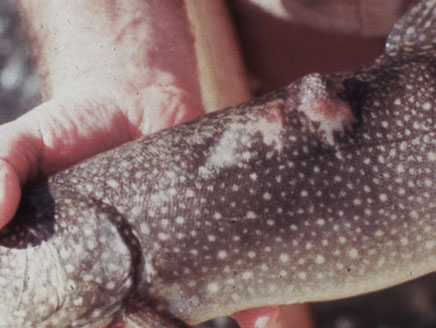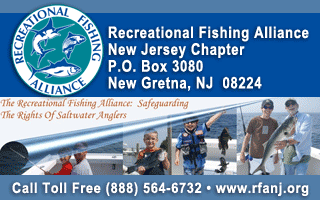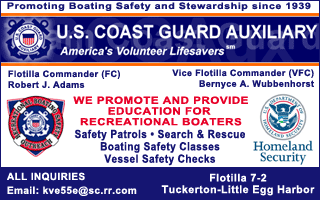
Should the NJ Division of Fish & Wildlife Release "Exposed" and "Treated" Pequest Trout into Our Warmwater Lakes & Rivers...YOU Decide!
By Tom Vassallo
With New Jersey's pre-season trout stocking set to begin on March 17, there are still some unanswered questions related to the impact of the furunculosis outbreak last fall at the Pequest Hatchery in Oxford, New Jersey. Specifically, many anglers may have reservations about the New Jersey Division of Fish & Wildlife's proposed changes to the stocking plan which would permit the Pequest hatchery trout classified as "exposed" and "treated fish" to be placed into "put and take" warm water fisheries throughout the eastern, central and southern areas of the state. The recommended changes to the stocking plan were first unveiled in a public notice released by the division in early February and publicly discussed at the Fisheries Forum meeting held in Batsto on February 22.
The reason for the proposed changes in the stocking plan is due to the outbreak of furunculosis, a serious, septicemic, bacterial disease found principally in salmonid fishes. The disease is caused by a gram-negative bacterium, Aeromonas salmonicida (A. salmonicida). Furunculosis is found worldwide with few exceptions and causes disease in many species of both coldwater and warmwater fishes. In trout hatcheries in North America, it accounts for a high percentage of the fish losses attributable to infectious diseases. Affected fish usually become darker in colour, lethargic and anorexic with reddening of the fin bases. However, development of 'furuncles' (lesions) on the dorsal body are the exception rather than the rule and primarily occur in older fish suffering from the chronic form of the disease.
 |
| In this file photo from the Vermont Dept. of Fish & Wildlife, a trout with advanced furunculosis displays "furuncles" or lesions. However, these advanced stages are rarely seen in hatchery outbreaks such as at Pequest Hatchery. |
According to figures released by the division, the initial fish at the hatchery affected with the disease included about 20,000 two year old brook and brown trout intended for the 2013 fall stocking. Nearly 25,000 fish were euthanized in an initial attempt to control the spread of the disease. However, several weeks later it was determined that over 275,000 brook and brown trout slated for the 2014 stocking this spring were also affected. These hatchery fish were initially treated with an antibiotic "Aquaflor", frequently used to control the disease in hatchery and farmed fish. However, further testing indicated the continued presence of the disease, which prompted a second additional regimen of treatment with the antibiotic.
The release of the division's public notice included the specific categorization of trout that are currently in the hatchery population at Pequest. That categorization is based on the "infection status" of the fish and are as follows (boldface added by FishinJersey.com for emphasis):
1) Negative fish are a population of fish which have been tested and the bacterium has never been detected. No restrictions will be made on the stocking of these fish.
2)Negative and exposed fish are a population of fish which have been tested and the bacterium has never been detected. These fish have been held in downstream water of a raceway that has undergone an outbreak of furunculosis. It is believed that these fish could be potential low level carriers of the bacterium. These fish will not be stocked into trout production waters. They may be stocked into trout maintenance or non-trout waters.
3) Positive fish are a population of fish in which the bacterium has been detected from the fish using the above mentioned sample size. These fish may show active signs of the disease or are asymptomatic and test positive for the bacterium. These fish will not be stocked into state waters.
4) Treated fish are a population of fish in which the pathogen has been previously detected, gone through a mitigation period, and subsequently test negative for the bacterium as outlined in 1) above. These fish will be considered as carriers of the bacterium and will only be stocked in waters that do not support trout (non-trout waters such as warmwater lakes and rivers).
What has raised a red flag with the editors here at FishinJersey.com, is that the division also noted in the public notice: " Furunculosis is typically a disease of salmonid fish, although it has been documented in other fish species in both marine and fresh waters, including smallmouth bass, American eel, muskellunge, northern pike, carp, suckers, shiners, minnows and flounder."
It is important to note that these types of outbreaks are primarily limited to hatchery and farmed fish. The unique stressors that are inherent in those environments are usually not present in the wild. However, our own research has uncovered additional evidence of furunculosis outbreaks in the Midwest in populations of white bass and yellow bass in the wild. Research has also determined that fish that host latent infections are the prime reservoir of infection. What makes the presence of A. salmonicida even more troubling is its ability to survive on wet or dry nets for 6 days and in tissues of fish that died from furunculosis for 32 days. Water, fish tissues, or contaminated equipment can therefore serve as sources of infection. Mutant strains of A. salmonicida have also survived 24 days in natural brackish water, 17 days in non-sterile fresh water, and 8 days in seawater.
We at FishinJersey.com are not convinced that placing "exposed" and "treated fish" in New Jersey lakes and rivers is the proper decision. New Jersey's rivers are highways that lead to our bays and ocean. Should we gamble on the continued health of our New Jersey warmwater and marine fisheries over a population of "put and take" fish that will only be taken back out or end up as prey for other fish and turtles? We would prefer to see them sold for consumption by animals or for use in fish meal, etc. Studies have shown that if heated to an internal temperature of at least 140 degrees, the fish is safe for consumption and/or processing. We adamantly oppose placing the exposed and/or treated trout in ANY New Jersey waters.
Yet we also believe that the NJ Division of Fish and Wildlife should be applauded for the extensive effort made to contain the outbreak and also for the recommended stocking changes that would protect New Jersey's holdover and natural trout fishery. Both FishinJersey.com and the division feel that only you, New Jersey's anglers, are those who need to decide what should be done next. That is why the division is requesting your immediate input before the new changes go before the Fish & Game Council for a vote on March 11, 2014. There is a survey and comment form that can be quickly filled out online. Please take the time to make your comments known on this important issue by clicking on this link: http://www.njfishandwildlife.com/trout14_comment.htm















